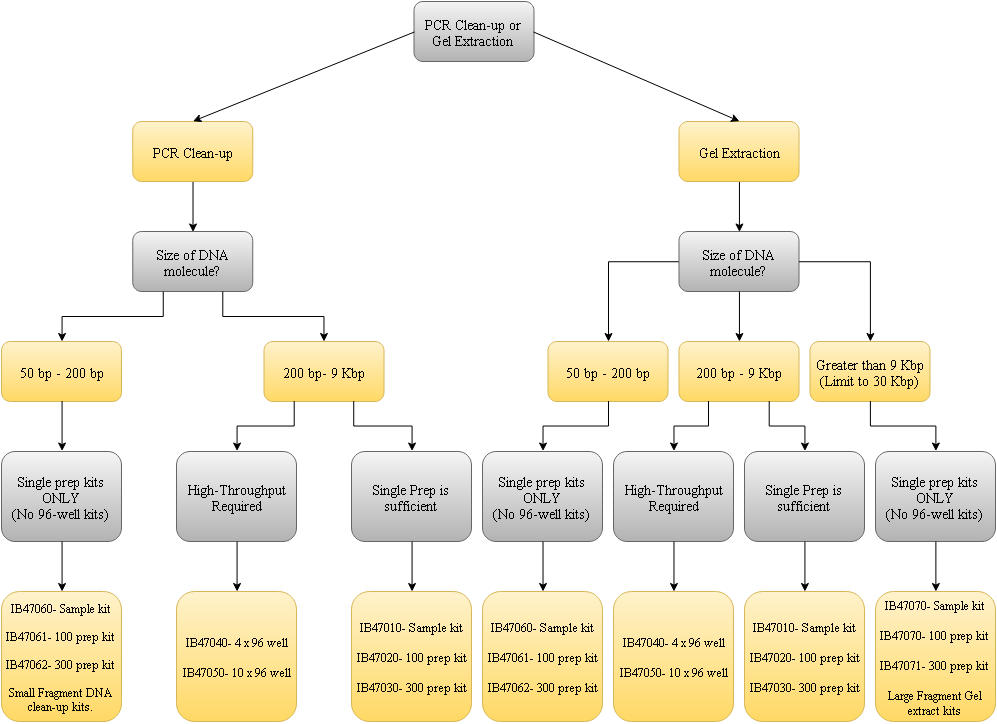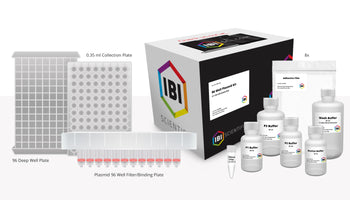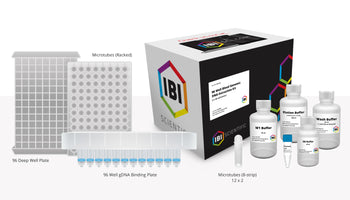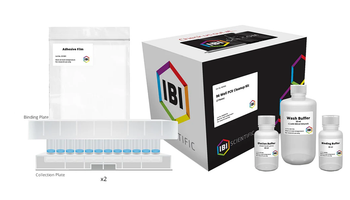
- Specifications
- Protocol
- Technical Information
- Replacement Buffers
- Replacement Columns & Collection Tubes
Physical Specifications:
Sample Size: up to 300mg of agarose gel / up to 100µl of PCR product.
Format: Spin column
Operation: Centrifuge or vacuum manifold
Binding Capacity:10µgDNA
Max Fragment size:<10kb
Expected yield:80-90% for gel extraction / 90-95% for PCR clean-up.
Elution volume:20 – 50µl
Operation time:20 minutes or less
Applications:PCR, Fluorescent or Radioactive Sequencing, Restrictive Digestion, DNA Labeling, ligation.
Protocol Link:
Technical Graph:
The following graph is to help determine what kit to acquire. Some kits can be used for both PCR Clean-up and Gel Extraction.
Can the PCR/Gel Extract kit be used with the aqueous layer generated during a phenol/chloroform extraction?
Yes, the IBI PCR/Gel extract kit will work with the aqueous layer generated during a phenol/chloroform extraction
What are the competition’s comparable kits?
QIAquick Gel Extraction Kit OR QIAquick PCR Purification Kit
The TBE buffer was used to run gels. Why am I achieving low DNA yields from the gel extraction?
Make certain the TBE buffer is fresh. Do not run numerous gels using the same buffer. This changes the pH of the buffer and affects the yield of the gel extraction.
Can I use water for the elution step if I run out of Elution Buffer?
In most applications; 10 meg ohms, Type 1 D.I. water, will work for the elution step if no buffer is available. However, this will not work for all applications, so we cannot guarantee it.
In a competitor’s kits it was found that an Isopropanol step during lysis can help increase the yield for samples that begin with a very small amount of DNA. Does this work with the PCR/Gel extraction kit from IBI?
Yes, this step can be used in the IBI kit. Use 1µl of Isopropanol for every mg of gel slice. This is ONLY effective if the DNA molecule is between 500 bp and 4 kb. Anything outside this range and it does nothing to increase yield.
What is the makeup of the elution buffer?
The elution buffer is made up of 10 mM Tris-HCl, pH 8.0 at 25°C.
If I have SDS in my sample will it adversely affect the gel extraction?
A small amount of SDS in the sample will NOT adversely affect the gel extraction recovery.
Can I extract single stranded DNA from the gel slice using the PCR/Gel extract kit?
Yes, this kit will allow the extraction of single stranded DNA from the gel slice.
Is there a minimum amount of DNA required for use in the PCR/Gel extract kit?
The yield is directly proportional to the input. The less you start with the less you get in the end. Best to start with at least 0.5µg of DNA for PCR clean up and gel extraction.
What’s the purpose of the W1 Buffer vs. the Wash Buffer?
W1 contains chaotropic salt and ethanol. The chaotropic salt can inhibit and remove the enzyme activity, such as Taq polymerase and endonuclease. Wash Buffer contains lower concentrations of salt and will remove salts and proteins from the final sample.
Comparison of Gel/PCR Extraction Kits- IBI and Brand Q















